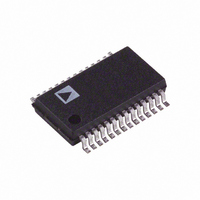AD1895AYRSRL Analog Devices Inc, AD1895AYRSRL Datasheet - Page 19

AD1895AYRSRL
Manufacturer Part Number
AD1895AYRSRL
Description
IC SAMP-RATEHP/CONV 24BIT 28SSOP
Manufacturer
Analog Devices Inc
Type
Sample Rate Converterr
Datasheet
1.AD1895AYRSZ.pdf
(24 pages)
Specifications of AD1895AYRSRL
Rohs Status
RoHS non-compliant
Applications
Automotive Audio, receivers, set-top boxes
Voltage - Supply, Digital
3.13 V ~ 3.46 V
Mounting Type
Surface Mount
Package / Case
28-SSOP
For Use With
EVAL-AD1895EB - BOARD EVAL FOR AD1895
Voltage - Supply, Analog
-
Lead Free Status / RoHS Status
Not Compliant
Available stocks
Company
Part Number
Manufacturer
Quantity
Price
Company:
Part Number:
AD1895AYRSRL
Manufacturer:
MOTOROLA
Quantity:
4 900
Part Number:
AD1895AYRSRL
Manufacturer:
ADI/亚德诺
Quantity:
20 000
OPERATING FEATURES
RESET and Power-Down
When RESET is asserted low, the AD1895 will turn off the
master clock input to the AD1895, MCLK_IN, initialize all of its
internal registers to their default values, and three-state all of the
I/O pins. While RESET is active low, the AD1895 is consuming
minimum power. For the lowest possible power consumption
while RESET is active low, all of the input pins to the AD1895
should be static.
When RESET is deasserted, the AD1895 begins its initialization
routine where all locations in the FIFO are initialized to zero,
MUTE_OUT is asserted high, and any I/O pins configured as
outputs are enabled. The mute control counter, which controls
the soft mute attenuation of the input samples, is initialized to
maximum attenuation, –127 dB (see Mute Control section).
When asserting RESET and deasserting RESET, the RESET
should be held low for a minimum of five MCLK_IN cycles.
During power-up, the RESET should be held low until the power
supplies have stabilized. It is recommended that the AD1895 be
reset when changing modes.
Power Supply and Voltage Reference
The AD1895 is designed for 3 V operation with 5 V input toler-
ance on the input pins. VDD_CORE is the 3 V supply that is used
to power the core logic of the AD1895 and to drive the output
pins. VDD_IO is used to set the input voltage tolerance of the
input pins. In order for the input pins to be 5 V input tolerant,
VDD_IO must be connected to a 5 V supply. If the input pins do
not have to be 5 V input tolerant, then VDD_IO can be connected
to VDD_CORE. VDD_IO should never be less than VDD_CORE.
VDD_CORE and VDD_IO should be bypassed with 100 nF
ceramic chip capacitors as close to the pins as possible to minimize
power supply and ground bounce caused by inductance in the
traces. A bulk aluminium electrolytic capacitor of 47 µF should
also be provided on the same PC board as the AD1895.
Digital Filter Group Delay
The filter group delay is given by the equation:
Mute Control
When the MUTE_IN pin is asserted high, the MUTE_IN control
will perform a soft mute by linearly decreasing the input data to the
AD1895 FIFO to almost zero, –127 dB attenuation. When
MUTE_IN is deasserted low, the MUTE_IN control will linearly
decrease the attenuation of the input data to 0 dB. A 12-bit counter,
clocked by LRCLK_I, is used to control the mute attenuation.
Therefore, the time it will take from the assertion of MUTE_IN
to –127 dB full mute attenuation is 4096/LRCLK_I seconds.
Likewise, the time it will take to reach 0 dB mute attenuation from
the deassertion of MUTE_IN is 4096/LRCLK_I seconds.
REV. B
GD
GD
=
=
f
f
S IN
S IN
16
16
_
_
+
+
f
S IN
32
f
S IN
_
32
_
seconds
×
f
f
S OUT
S IN
for f
_
_
S OUT
_
seconds
>
f
S IN
for f
_
S OUT
_
<
f
S IN
_
–19–
Upon RESET, or a change in the sample rate between LRCLK_I
and LRCLK_O, the MUTE_OUT pin will be asserted high. The
MUTE_OUT pin will remain asserted high until the digital servo
loop’s internal Fast Settling Mode has completed. When the digital
servo loop has switched to Slow Settling Mode, the MUTE_OUT
pin will deassert. While MUTE_OUT is asserted, the MUTE_IN
pin should be asserted as well to prevent any major distortion in
the audio output samples.
Master Clock
A digital clock connected to the MCLK_IN pin or a fundamental
or third overtone crystal connected between MCLK_IN and
MCLK_OUT can be used to generate the master clock, MCLK_IN.
The MCLK_IN pin can be 5 V input tolerant just like any of
the other AD1895 input pins. A fundamental mode crystal can
be inserted between MCLK_IN and MCLK_OUT for master
clock frequency generation up to 27 MHz. For master clock
frequency generation with a crystal beyond 27 MHz, it is recom-
mended that the user use a third overtone crystal and add an
LC filter at the output of MCLK_OUT to filter out the fundamental,
do not notch filter the fundamental. Please refer to your quartz
crystal supplier for values for external capacitors and inductor
components.
There are, of course, maximum and minimum operating fre-
quencies for the AD1895 master clock. The maximum master
clock frequency at which the AD1895 is guaranteed to operate is
30 MHz. 30 MHz is more than sufficient to sample rate convert
sampling frequencies of 192 kHz + 12%. The minimum required
frequency for the master clock generation for the AD1895 depends
upon the input and output sample rates. The master clock has
to be at least 138 times greater than the maximum input or
output sample rate.
Figure 9a. Fundamental Mode Circuit Configuration
Figure 9b. Third Overtone Circuit Configuration
AD1895
MCLK_IN
MCLK_IN
AD1895
C1
C1
MCLK_OUT
C2
R
MCLK_OUT
C2
R
AD1895
1nF
L1













